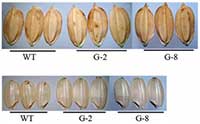Sep 29 2008
A team of scientists, including Penn State Distinguished Professor of Biology Hong Ma, has identified a gene in rice that controls the size and weight of rice grains. The gene may prove to be useful for breeding high-yield rice and, thus, may benefit the vast number of people who rely on this staple food for survival. "Our work shows that it is possible to increase rice's yield by enhancing the expression of a particular gene," said Ma. The team's results will be published on 28 September 2008 in an early online edition of the journal Nature Genetics, and in the November print issue of the journal.
 The researchers created transgenic lines of rice (G-2 and G-8) in which the GIF1 gene was overexpressed. Compared to normal strains (WT), they found that the transgenic rice had larger and heavier grains. In this figure, the grains on the top are from white rice and the grains on the bottom are from brown rice. Credit: Zuhua He, Chinese Academy of Sciences
The researchers created transgenic lines of rice (G-2 and G-8) in which the GIF1 gene was overexpressed. Compared to normal strains (WT), they found that the transgenic rice had larger and heavier grains. In this figure, the grains on the top are from white rice and the grains on the bottom are from brown rice. Credit: Zuhua He, Chinese Academy of Sciences
The researchers first searched for and identified mutant strains of rice that exhibited underweight grains. "We found a particular mutant that is defective in its ability to produce normal-sized grains," said Zuhua He, a biology professor at the Chinese Academy of Sciences and the leader of the team. The group then examined the mutant and found that it carried a mutation within the GIF1 gene. "The GIF1 gene is responsible for controlling the activity of the enzyme invertase, which is located in the cell wall and converts sucrose to substances that then are used to create starch," said He. "Invertase is important in the formation of starch within developing grains of rice. If invertase is not active, the rice plant cannot produce edible grains."
Next, to test the ability of the GIF1 gene to control the production of invertase, the team measured the activity of invertase within a normal strain of rice, in which the GIF1 gene lacked any mutations, and within a mutant strain of rice, in which the GIF1 gene contained a mutation that caused a defect in the invertase activity. The scientists found that invertase activity in the mutant strain was only 17 percent of the activity that was observed in the normal strain, suggesting that the GIF1 gene does, indeed, control invertase activity. The team then created transgenic lines of rice in which the GIF1 gene is overexpressed and found that, compared with normal strains, the transgenic rice had larger and heavier grains.
According to Ma, the team was surprised to find that the GIF1 gene was so specialized in controlling invertase activity in a particular part of the grain -- the vascular tissue, which transports nutrients, including sugars generated by invertase, to the developing grain. "The expression pattern was not expected, in part, because invertase is a general enzyme that is used by many cell types. In fact, the corresponding gene in wild rice is not expressed specifically."
The team also found that the GIF1 gene is one of the genes that were selected during the domestication of rice. "By selectively growing only those strains of rice with heavier grains, humans for thousands of years unknowingly have been increasing the frequency of rice populations that had modifications in the GIF1 gene," said Ma. "This process has caused GIF1 to be expressed specifically in the vascular tissue and, thus, to produce larger rice grains," said Ma.
The scientists hope that their findings will help others to create hybrid varieties of rice that produce even larger grains. In the meantime, they plan to perform additional analyses that will help them to understand how other genes might be involved in the process of improving rice yield. "The goal is to understand what controls grain weight and other factors, and to look for ways to increase yield," said Ma.